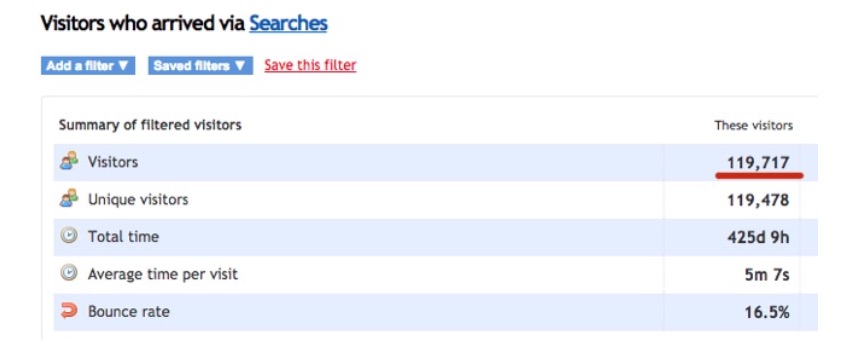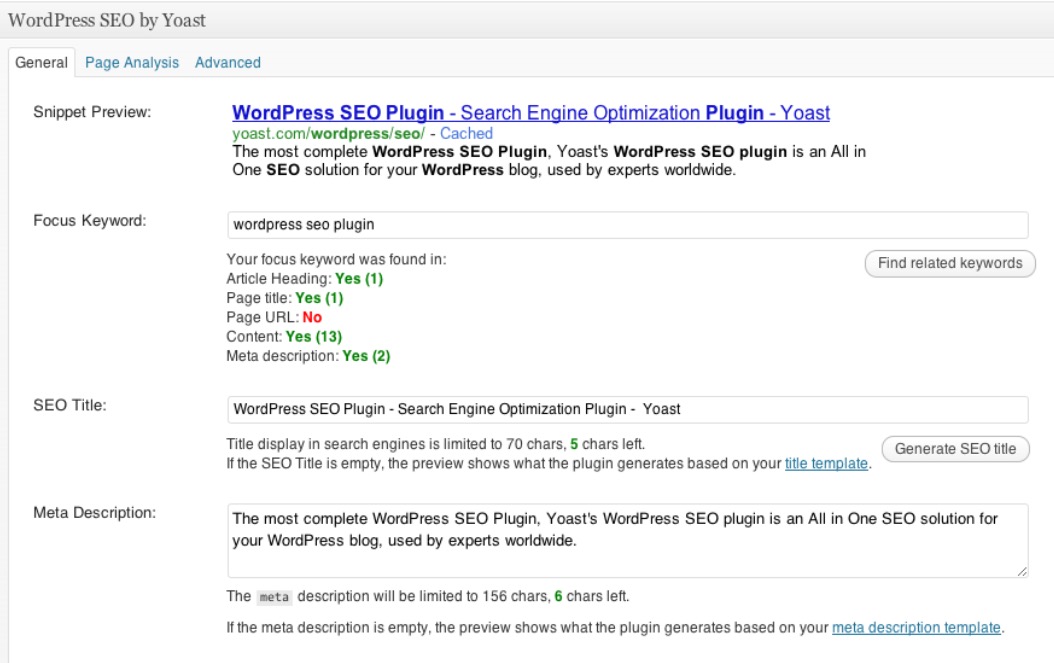
I’ll never forget the first time I got 100,000 visitors from Google traffic in one month. I still feel extremely lucky.. Today I’m going to show you how I think I did it.
When you first think about starting a blog you kind of don’t imagine you’ll ever get more than a trickle of traffic.
And then you have your first 100-visitor day.
Then your first 1,000-visitor day.
After a while you might even have a 10,000 or 20,000 visitor a day and you still can’t believe it’s happening.
What I want to do today is show you as much of what I did as possible in the hope that it helps your blog get more traffic. Let’s look at all the ins and outs of how to get over 100,000 visitors a month from natural organic Google search.
Things are so much nicer when you have a plan.
Why is Google traffic still the best?
If you’ve been reading Blog Tyrant for a while you’ll know that I occasionally warn against relying on Google too much.
And I stand by that.
Organic traffic from Google search is still the most valuable traffic you can get because it grows, it’s free (sort of), and people who are using search engines are usually in a buy-ready frame of mind.
A screen shot of my Clicky Analytics account showing one of my first 28 day periods where I had 100,000+ unique visitors hitting my blog from Google searches.
However, if your begin to rely solely on that traffic you run the risk of getting yourself into a bit of trouble in the longterm. Every time Google updates its algorithm there is a chance your blog is going to be less relevant.
And that means your traffic vanishes.
My own little story with this issue
I’ve told this story before but when I first got into blogging I had a few fitness blogs which made money pretty exclusively through Google Adsense. One day I woke up and all my traffic (and revenue!) had gone – I’d received a pretty significant Google penalty for some unknown reason.
Lucky for me, the traffic came back.
But it was a very scary experience and it taught me that I need to ensure that I have diversified traffic sources that act as a back up in case one of them gets accidentally or deliberately turned off.
How long does it take to get 100,000 visitors a month from Google?
Something I want to stress in this post is that my approach to Google traffic is one that is very clean, natural and safe.
And “safe” isn’t always a word that sits well with entrepreneurs.
Because it usually means slow.
If you’re after some short term SEO tricks to help you get an inferior website ranked in two weeks then this isn’t the post for you. This is all about a high-value approach to blogging that you can use on a site that you love and don’t want to take unnecessary risks with.
But saying it will take 6 months or a year is kind of irresponsible of me because every blog and niche is different. It will depend a lot on how prolific you can be, and how willing you are to learn a new approach.
How to get 100,000 visitors a month from Google
Okay, now we can get into the real tofu and potatoes of the post.
And, as always, if you get to the end and think I’ve missed something important or have any questions please leave a comment and let me know.
1. Choose a topic, keywords and target market that has the depth
The very first thing you need to do if you want to have a good SEO strategy is know what keywords you are going after and what target market you are trying to tap into.
Too often I see blogs that have a very generalised topic which leads to a lot of fragmented content, an unresponsive mailing list and not a lot of success.
When researching your topic, please make sure you know what you want to talk about and how your blog is going to be different to all the others out there. It is very important that you think about deliberate ways that your topic is going to stand out.
When researching keywords, it’s a good idea to know who your competition is and how saturated the market is. There are some niches that are very, very hard to compete in. The main worry, however, is a niche with not enough traffic.
One simple place to start is by logging into Google Adwords and using their suite of Tools. One of them will estimate search volume and show you the Adwords bidding competition. This will give you a pretty good idea about whether your market is worth the effort.
Make sure you try a lot of variations of your keywords here. Even small changes like plurals or alternative words that seem similar can have a massive effect on traffic numbers.
At this stage you’ll also want to look at your competition using a service like Majestic to see what keywords are going around, who is working on what, etc. You can then go and spend some time manually searching and clicking through to websites to see if there is anything that you can do better than what is already out there.
At this point I’d like to just mention that passion really is the most important thing here. It’s something I’ve heard successful bloggers like Glen from ViperChill say again and again. Even if you find a profitable niche to work in, you’ll soon lose interest at all the hard (and boring tasks) if you don’t love it and sincerely want to help your readership.
That is very important.
2. Get your own domain name and self-hosted WordPress setup
How many times have you seen a free blog like Tumblr or Blogger in the first position on Google? Not often is the answer.
Google gives a much higher weighting to websites and blogs that have their own domain name and host because it is a pretty basic signal that that website is going to be taking itself more seriously – hence better quality. Here’s a quick video explaining my preferred setup.
So how do you choose a good domain name? Well, there are several options:
* Exact match keywords
A few years ago if you could get an exact match phrase you’d be more likely to rank at the top. Now this isn’t so popular and can look a bit spammy. However, for local search, things like ArchitectMelbourne.com.au still rank extremely well if you can get them.
* Keyword + noun
Another popular method is to take the keyword that you are targeting and add a noun or adjective to it. Blog Tyrant could be an example of this approach if I was targeting the keyword “blog”.
* Distinctive domains
This is actually now the best option given that all the good keyword domains are taken. Being distinctive is important. Look at a site like ViperChill where the domain name has nothing to do with anything but you’ll never forget it.
Once you’ve decided on your domain name you can register it and do all your WordPress set up through BlueHost. This is a good idea because then everything is in the one place. Here is a tutorial on how to start a WordPress blog and bit more about blog hosting in general if you’re interested
3. Change your general WordPress settings for better SEO performance
For the most part, WordPress is a pretty SEO-friendly platform. That being said, there are a few little default things that we want to change from the get go.
The first is your default permalinks structure which is often set to some combo of the date and name. I like to set this to just post name as we will want the keywords that we are targeting to show up in the post. Just go Settings > Permalinks > Post Name.
Remember, if you already have your blog up and running you don’t want to change any existing permalinks as that will result in any links pointing to that old structure to throw an error. We only want it for future things.
The next thing you want to make sure is that your post titles are set to h1 tags and not anything else. Often you find that WordPress themes have the site name as the first header and then the post title is h2 which is a mistake. You can change this by going Appearance > Editor > Single Post and then changing your post title to the right tag.
The last basic WordPress thing we want to change is your sidebar. Get rid of everything in there except for an email subscriber opt-in formand maybe some links to your most popular posts. You don’t need all that Meta stuff in there, and you especially don’t want any blogroll links.
4. Install an SEO-specific plugin like WordPress SEO by Yoast
Now you’ll want to get a little more advanced and install a plugin that has been specifically designed for improving your WordPress blog’s search engine performance. The most popular and well respected is WordPress SEO by Yoast.
This plugin is actually quite intimidating for beginner/intermediate level bloggers. There are a lot of settings and options and you will be introduced to a whole new lexicon of SEO-related words.
Don’t panic
Firstly, Yoast has written a really comprehensive guide on how to get yourself properly setup. Secondly, it’s not the kind of thing you need to get totally correct before you do anything else – you can tweak as you go. I would earmark half a day of your time to add the plugin and go through the above article making changes and then just leave it for a while.
The great thing about this plugin, as you can see above, is that it will tell you if you are making any large mistakes or errors as you go along. Combine this with the installation guide and you will find yourself learning a lot about SEO best practices for a WordPress blog setup.
5. Carefully tweak and improve your user experience ranking factors
The above plugin and settings mostly tweak your site to make it look better in the eyes of Google bots. But what we want to do now is make sure it looks good in the eyes of your human readers.
The interesting thing about this is that improving a blog’s user experience also leads to a better ranking performance because Google only wants to refer its customers to highly useful sites.
Start by making sure you have a mobile responsive WordPress theme. This is especially important since the Google mobile update that happened a few weeks ago.
If you’re not sure whether your site looks good to Google then use their mobile testing tool.
The next most important user experience ranking factor is speed. Google only wants to send visitors to website that load extremely quickly because they know that people are impatient. If your site is taking longer than about 2-3 seconds to load then it is too slow.
Below is a screenshot of a speed test I did on Blog Tyrant using Pingdom Tools where the results are very positive. Of course, this speed varies depending on the location of the user, how many people are on the website, etc. but overall my site is loading pretty well.
Some of the basic things you can do to ensure your blog is loading quickly include:
* Shrinking images
I’m always surprised at how often bloggers upload images that are > 2MB. It’s too large. Ideally you want to shrink your images down to around < 50KB or smushthem.
* Talking to your server technicians
If you are on a good web host you will usually find that your server technicians will offer you some free advice on how to best optimise your blog. Open up a support ticket and tell them you need to make some site speed improvements and see what tips they give. They can do things like enabling GZIP which is a server-side speed improvement.
* Using a caching plugin
Caching is another big topic that takes a while to get your head around. A lot of it can be done on the server side of things, but there are also several good WordPress plugins like W3 Total Cache which you can install and get good results with.
Now that you’ve taken some steps to speed up your blog, you’ll want to start looking at the layout of your theme and ensuring that you have the design setup in a way that will encourage visitors to take an action.
For example, it’s a very good idea to ensure that you important stuff is above the fold. This is the area of your blog that people see before they have to scroll. Any opt-in forms, calls to action, etc. really need to be in this area, or at least catered to in a design that encourages scrolling.
You’ll also want to look at things like your typography and replace any slow self-hosted fonts with either web safe versions or a Google Font version which always seem to be quicker and you can test out text to see what looks nice.
Make sure you use a large, easy to read font size that fits with your branding. The general wisdom is that fonts like Arial, Verdana and Georgia are good choices because people are used to reading them and thus it feels familiar.
6. Create strategic content based around keywords, value and point of difference
Ever since I first sold a blog in college I’ve preferred to approach blogging, SEO and online business with a “quality first” attitude where my stuff hopefully helps people.
And one of the mantras you hear a lot in the blogging world is the idea that content is king.
Well, I actually think that is a pretty ordinary phrase.
Quality content alone is not enough. It needs a strategy. – Tweet this.
If you really pay attention to what is appearing at the top of Google these days you’ll notice that there is a mix of local stuff, videos, long form content, aged content, fresh content, photos, etc. Have a look at a few results for the term “email marketing”.
It is quite varied.
So instead of just attempting to write something “quality”, what we need to do is really dig deep into the niche and figure out what we can create that is not only useful, but different. How can I make something that will get attention?
That is very important.
But that content that we create also has to form part of an overall blogging strategy otherwise it is all a complete waste of time. There is absolutely no point in getting over 100,000 visitors to your blog each month if they aren’t taking some type of action towards your goals.
7. Leverage other sites’ authority and build links by providing value around the web
There is something quite intangible about this point but I want to write about it anyway because I feel like it has been really important for my own Google rankings.
Over the last few years I’ve noticed something interesting.
If you can write something really good about a topic everyone knows but have a new angle to it, and then get yourself in front of influencers regularly, you will find that they start to link to your articles quite naturally.
In the last few weeks alone I’ve had links from Neil Patel, Moz and Search Engine Watch all for things I’ve done on my About page or my article about About pages!
Another example would be the link I got on Boost Blog Traffic for an article about controversial titles where they featured a controversial title that I wrote.
Simple stuff.
This is another example of the fact that you don’t have to be first in your niche, you just have to try to find a way to stand out and be noticed. Sometimes you can do that with something as basic as your own personal story.
One of the other ways I do this is to make sure I link to all my favorite bloggers regularly when I write something that I think is pretty good. Bloggers really love getting links, and if you’ve included them on some awesome new resource that you’ve made you might just find that they link back to another one of your posts when they’re writing something new.
If you’re doing a guest post on someone else’s blog then this is the absolute best time to mention someone that you’d like to get in front of.
8. Update old stuff (including titles and descriptions)
These days Google is giving a lot of weight to fresh content.
What that means is that some of the brilliant articles that you wrote five years ago, even though they may be the best thing on the web, might not be appearing as high as they should be because some new whipper snapper is stealing your thunder.
One way to combat this is to go back and figure out which posts might need a bit of a fresh coat of paint and add things like new information, graphics, photos, videos, etc. and really make it feel modern again.
One of the good things about the WordPress SEO plugin mentioned above is that it lets you re-write your titles for search engines. One of the main reasons you might want to do this is to show that it has been updated.
For example, in 2014 I wrote a post about the things to know before starting a blog in that year. The content is still perfectly relevant today in 2015 so I updated the description to reflect that fact.
If it still had the old 2014 information in there I might see a lot fewer people clicking through from Google. I don’t recommend you go and do this for every post in your archive either – just try and keep the posts that need to be updated updated.
9. Reinvest part of your earnings to increase exposure
Advertising on Facebook Ads and Google Adwords is actually a really big part of good SEO.
Expert SEOs are going to laugh at me for saying that but I don’t care, hear me out.
When you have a really good piece of content that you’ve invested countless hours into researching, writing and editing, you want to make sure it does well. Now, even if you main goal is to get that article to rank on Google you’ll want to make sure you spend money on social advertising.
And the reason is simple.
The wider reach your article has the more likely it is to get seen by someone who’ll eventually link to it.
Think about it.
You can go onto Facebook and in five minutes create an advert that will target only people interested in XYZ niche. That might include other bloggers in the XYZ niche – hopefully even some influencers. If your article is any good it’ll be on their radar next time they are writing about that topic.
This type of promotion works extremely well for long form content and types of content that people can download and use as an everlasting resource. I reckon I’ve probably link to Jon Morrow’s headline PDF at least five times.
10. Listen to Google but don’t be afraid of Google
One of the things that I’ve learned from ViperChill that I’m very grateful for is the idea that you should listen to Google but not always be afraid that you are doing something terribly wrong.
Glen takes a lot of risks with his SEO approach, something that I’m not willing to do here, but he’s also kind of helped me loosen up about trying out new things without fear of a Google penalty.
I wrote about one example in my post on why guest posts still work.
When Matt Cutts told everyone that guest posts were a dangerous way to build backlinks everyone just kind of stopped doing guest posts.
That’s silly.
Guest posting is still a fantastic way to get traffic to your site and find a whole new readership, many of whom will link to your content, promote it on social media and share it with their own audiences. So guest posting for SEO is still very much alive, it’s just smarter now.
Make sure you know what Google wants and doesn’t want, but don’t be so scared of the rules that you stop making content that people want to consume.
One practical task you can do right now
I want to end this post by giving you one practical task that you can start today that will get you closer towards your first 100,000 visitors from Google in a single month.
Start by reading this post (I’m assuming you have if you’re this far) and taking into account all the ideas on keyword research, strategic content, etc. your task is:
Write one brilliant post of at least 3,500 words (include links to big bloggers in your niche, graphics, photos, etc.) based around one strategic keyword set and a point of difference. Find another blog to give it away to as a guest post.
This is something that I notice a lot of bloggers still really struggle to do. When it comes to getting traffic from Google a lot of it really starts with getting your name out there and building links by building up your brand awareness. And that can be done really simple with some good guest posting.
How much traffic do you get from Google?
If your getting up to 10,000 unique visitors a day you should consider joining the Slay black membership program to spread your risks. It is a highly lucrative and exciting program click here to join
By blogtyrant.com









